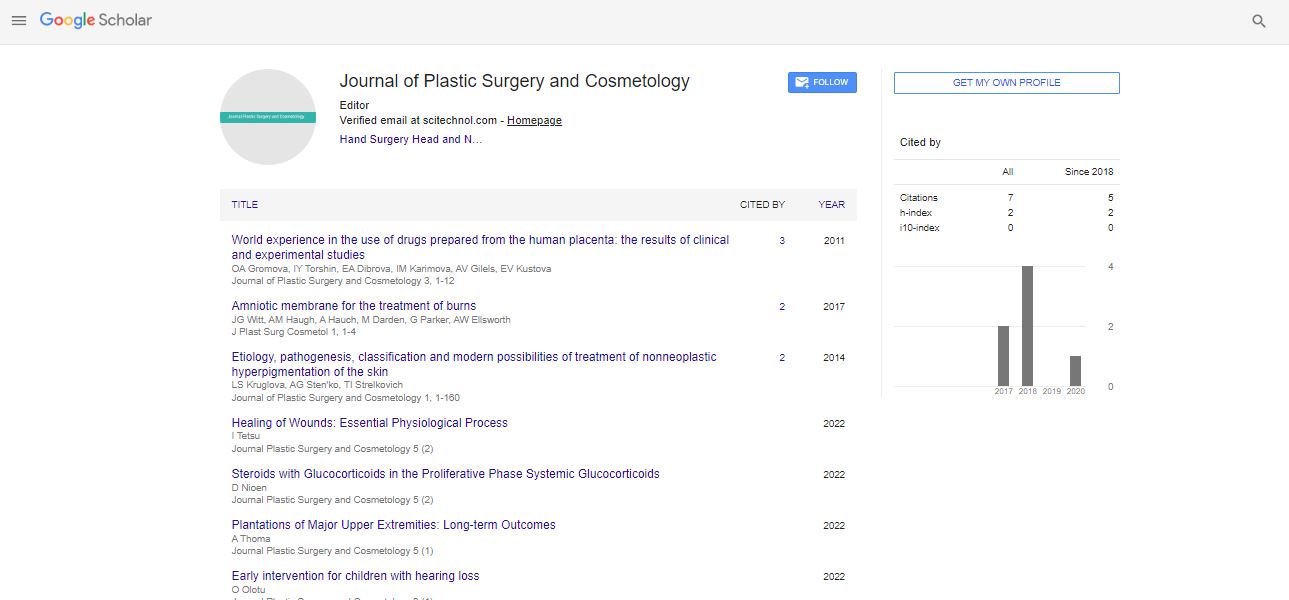Commentary, J Pls Sur Cos Vol: 12 Issue: 4
Contours of Transformation: Challenges and Innovations in Post-Bariatric Body Sculpting
Myler Clorrk*
1Department of Plastic Surgery, Medical College of Wisconsin, Milwaukee, Wisconsin
*Corresponding Author: Myler Clorrk,
Department of Plastic Surgery, Medical
College of Wisconsin, Milwaukee, Wisconsin
E-mail: Myler_cl902@gmail.com
Received date: 27 November, 2023, Manuscript No. JPSC-24-123949;
Editor assigned date: 29 November, 2023, Pre QC No. JPSC-24-123949 (PQ);
Reviewed date: 14 December, 2023, QC No. JPSC-24-123949;
Revised date: 21 December, 2023, Manuscript No. JPSC-24-123949 (R);
Published date: 28 December, 2023, DOI: 10.4172/JPSC.1000068
Citation: Clorrk M (2023) Contours of Transformation: Challenges and Innovations in Post-Bariatric Body Sculpting. J Pls Sur Cos 12:4.
Description
The transformative impact of bariatric surgery on individuals with obesity is undeniable, leading to substantial weight loss and improved health outcomes. However, this significant weight loss often results in excess skin and changes in body contour, prompting the need for body contouring procedures. This essay examines the challenges associated with body contouring after massive weight loss from bariatric surgery and explores the innovations that have emerged to address these challenges. The primary challenge following massive weight loss is the presence of excess skin and soft tissue deficiency. The skin, stretched during periods of obesity, often loses elasticity and struggles to conform to the reduced body volume. This results in hanging or redundant skin folds, particularly in areas such as the abdomen, arms, thighs, and breasts. The distribution of excess skin varies among individuals, presenting a complex challenge for plastic surgeons. The variability in skin laxity and distribution necessitates a personalized approach to body contouring procedures to address the unique needs and concerns of each patient.
Excess skin following bariatric surgery can have a profound psychological impact on individuals. Despite achieving significant weight loss and improved health, the presence of excess skin may lead to body image dissatisfaction, self-esteem issues, and challenges in adapting to the transformed body. Psychological considerations are integral in the comprehensive care of post-bariatric surgery patients. The circumferential body lift, also known as a belt lipectomy, is a comprehensive procedure designed to address excess skin around the torso. This procedure involves the removal of excess skin and fat from the abdomen, lower back, and buttocks, resulting in a more streamlined and contoured midsection. Innovations in surgical techniques aim to minimize scarring and improve overall aesthetic outcomes.
Brachioplasty, or arm lift, and thigh lift procedures focus on removing excess skin and tissue in the upper arms and thighs, respectively. These surgeries are tailored to address the unique challenges presented by lax skin in these areas. Innovations include modifications in incision patterns and tissue manipulation to achieve improved contouring and reduce visible scarring. Breast surgery, including breast lift or mastopexy, breast reduction, or augmentation, is often a crucial component of body contouring after massive weight loss. Innovations in breast surgery focus on achieving a harmonious and natural appearance, addressing changes in breast shape, volume, and ptosis resulting from weight loss. To optimize outcomes and minimize overall recovery time, surgeons increasingly explore the potential benefits of combining multiple body contouring procedures in a single surgical session. This approach, known as a combination or staged procedure, addresses various areas of concern comprehensively while reducing the need for multiple surgeries and associated recovery periods.
Minimally invasive techniques, such as liposuction and fat grafting, play a role in body contouring by addressing localized pockets of fat or contour irregularities. Liposuction removes excess fat through small incisions, while fat grafting involves transferring a patient's own fat to areas that may benefit from additional volume, such as the buttocks or breasts. Emerging technologies like radiofrequency and laser-assisted devices offer non-surgical alternatives for skin tightening and contouring. These modalities stimulate collagen production, improving skin elasticity and reducing the appearance of mild to moderate skin laxity. While not a substitute for surgical procedures, these technologies may provide additional options for certain patients. Patient safety is paramount in body contouring procedures following bariatric surgery. Thorough medical evaluations are essential to assess a patient's overall health and identify any potential contraindications. Patient selection criteria consider factors such as nutritional status, weight stability, and overall fitness for surgery.
 Spanish
Spanish  Chinese
Chinese  Russian
Russian  German
German  French
French  Japanese
Japanese  Portuguese
Portuguese  Hindi
Hindi 